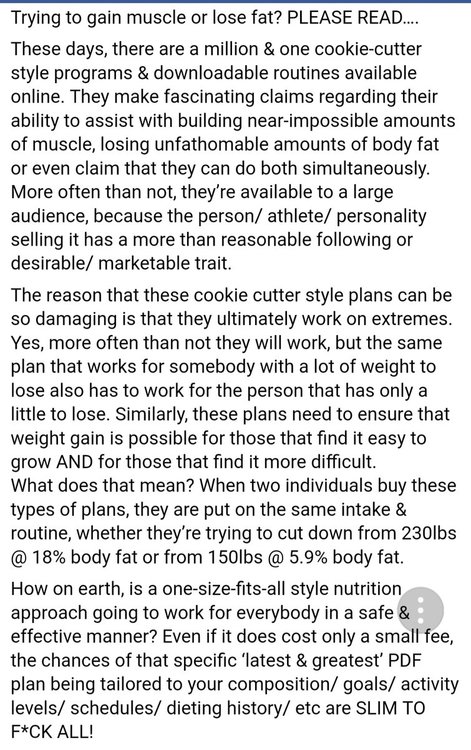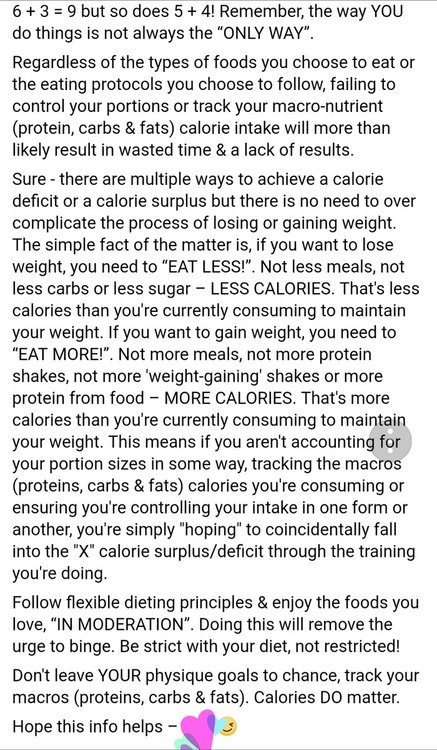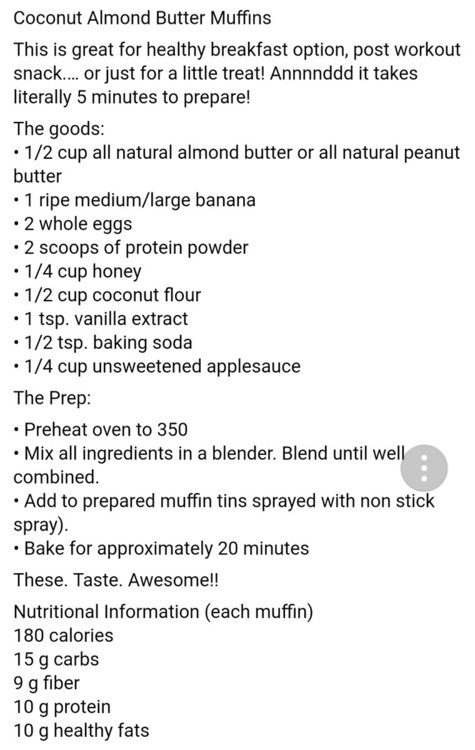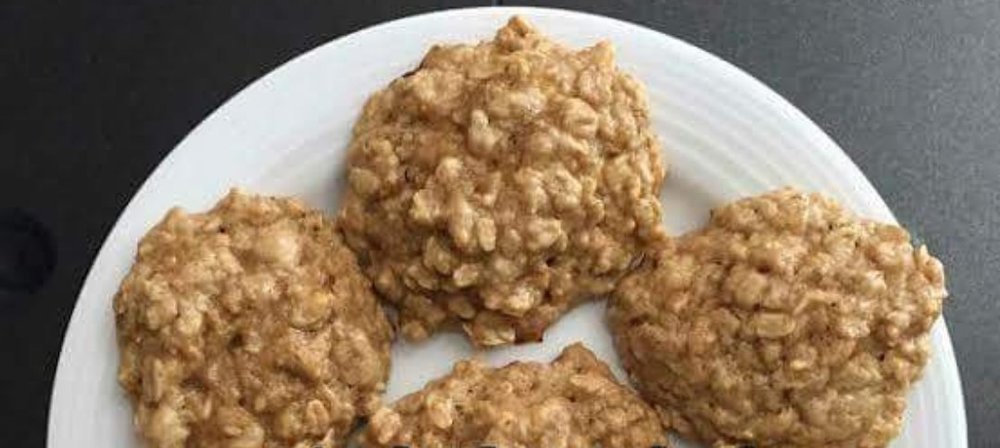-
Posts
912 -
Joined
-
Last visited
-
Days Won
71
Everything posted by musclebeauty
-

COOKIE CUTTER STYLE PROGRAMS
topic replied to musclebeauty's musclebeauty in Nutrition, Diet and Recipes
I know its such a shame and people pay so much money too...diet has to be sometimes through trail and error for me it took me a few years to nail down what works for my body....? -

Coconut butter almond muffins
topic replied to musclebeauty's musclebeauty in Nutrition, Diet and Recipes
Thankyou Olympic ? -

Coconut butter almond muffins
topic replied to musclebeauty's musclebeauty in Nutrition, Diet and Recipes
Nice and easy to make ? -
Welcome to NL ?
-
Welcome to NL ?
-
Welcome to NL ?
-
Welcome to NL ?
-
Welcome to NL ?
-
Welcome aboard ?
-
-
A great read and i love all sorts of nuts and seeds... Nuts are the ultimate health food. High in protein, rich in healthy fats, and low in simple carbohydrates, nuts stimulate your body to burn excess fat and shed extra pounds. Plus, they make an incredibly versatile addition to your diet. Nuts are a handy snack to stash in your purse, taste great atop a mixed salad, and can be added to your favorite smoothie recipe for a protein boost. When eating nuts for weight loss, remember to keep calories in mind. Nuts are an incredibly energy dense food, meaning that they pack a lot of nutrients into a relatively small size. Although this means that you get a lot of nutritional benefit from nuts, it also means that eating a huge serving of nuts could add extra calories to your diet (Mayo Clinic, 2015). In spite of this, nuts have been scientifically proven to help you shed pounds. In a review of scientific literature on the topic, researchers found that eating nuts is associated with greater weight loss, better diet compliance, and improved satiety (Mattes, Kris-Etherton, & Foster, 2008). Choose one of these nuts for weight loss success. Almonds for Weight Loss Almonds are considered one of nature’s “superfoods” for their rich content of protein, antioxidants, and heart-healthy fats. This makes them an excellent addition to your weight loss diet. In fact, in a study of 65 overweight or obese adults, eating a diet high in almonds was associated with greater weight loss, decreased waist circumference, lower body fat, and reduced systolic blood pressure (Wein et al., 2003). These benefits are thought to be due to almonds’ high content of monounsaturated fats. Out of the 11 grams of fat in a serving of almonds, 7 grams are from these beneficial monounsaturated fatty acids (WH Foods, 2015). Cashews for Weight Loss Light in color and delicate in taste, cashew nuts have a unique curved shape. One serving of these nuts (about 16 to 18 nuts) contains 13 grams of fat and 5 grams of protein (MacMillan, 2015). Plus, cashews are an excellent source of magnesium, with a 100-gram serving (about an ounce) providing 73% of your recommended daily value of magnesium (Nutrition and You, 2015). Magnesium is essential for regulating the metabolism of fat and carbohydrates (Volpe, 2014), which may help you lose weight. In addition to eating raw cashews, spreading cashew butter on whole-wheat toast is a great way to boost your consumption of these healthy nuts. Brazil Nuts for Weight Loss Large Brazil nuts have a unique texture and flavor that makes them a favorite of many. These nuts contain beneficial palmitoleic acid and oleic acid, which promote healthy cholesterol levels (Nutrition and You, 2015). Plus, Brazil nuts are one of the best known sources of the trace mineral selenium. Each serving of Brazil nuts contains more than 100% of your recommended daily intake of selenium, which acts as an antioxidant that may boost your immune functioning (National Institutes of Health, 2016). Walnuts for Weight Loss Like all nuts, walnuts are high in heart-healthy unsaturated fats. However, walnuts are unique in that they contain high levels of polyunsaturated fats (other nuts typically contain high amounts of monounsaturated fats). There are several types of polyunsaturated fats; the form found primarily in plant foods is known as alpha-linolenic acid, or ALA. ALA has been shown to decrease risk of cardiovascular disease and other chronic conditions (Erlich, 2014). It may also stimulate your body to lose weight faster. Walnuts contain 2.5 grams of ALA per serving, making them a rich source of this beneficial fatty acid. In a recent study of 245 women, a walnut-rich diet was associated with greater weight loss, lower levels of “bad” LDL cholesterol, and higher levels of “good” HDL cholesterol (Le et al., 2016). This suggests that eating a handful of walnuts every day could help to stimulate fat loss and promote a healthy body weight. Pistachios for Weight Loss The delicate green color and unique flavor of pistachios make them a favorite to toss into smoothies, to add to baked goods, or to simply eat as a snack. Each one-ounce serving of pistachios contains 3 grams of dietary fiber, or 12% of your recommended daily intake (Self Nutrition Data, 2015). Getting enough dietary fiber helps your body feel fuller, sending signals to your brain that prevent you from experiencing intense food cravings. This can help you lose weight and burn more fat. In a recent scientific study, a pistachio-rich diet was associated with significantly smaller waist size, a sign that participants on the high-pistachio diet dropped excess belly fat (Girdwain, 2014).
-
Welcome aboard and enjoy the site?
-
Welcome and enjoy the site?
-
Welcome and enjoy the site?
-
Welcome aboard and enjoy the site?
-
Welcome and enjoy the site?
-
-
Metabolism is a tricky matter. Just like DNA, metabolic rate is unique to each person, meaning that boosting your metabolism is going to be different for everyone, too. Some people experience a slow metabolism (meaning fewer calories are burnt) because of a sluggish thyroid or poor diet choices, while others enjoy a fast metabolism (meaning more calories used) due to a healthy diet and lots of exercise. But regardless of how your metabolism naturally functions, there are certain things you can do to help it along. If you're looking to boost your metabolism, try incorporating these seven foods into your diet. Blueberries Providing 14% of your daily fiber intake in a single cup, blueberries will make you feel fuller and boost your body's ability to convert nutrients into some serious energy! Start your morning by spreading some tasty blueberry chia seed jam on toast or pop a few blueberry crumb bars into your bag for an afternoon pick-me-up. Almonds They may be small, but almonds are packed with nutrients. A handful will supply plenty of fiber, protein, and healthy fats, which can help you burn calories and manage your weight. Roast some almonds for a quick snack. Coconut Oil Coconut oil is made up of medium-chain triglycerides, which is a kind of lipid that rapidly metabolizes in the body. This leads to a longer lasting feeling of satiety—in other words, you'll be less likely to start snacking an hour later. For a healthy dessert option that features coconut oil, try some gluten-free banana bread. Cayenne Pepper A popular spice, cayenne pepper can help to speed up your metabolism. It contains capsaicin, a compound that creates heat within the body to rapidly convert calories into energy. You can also find capsaicin in other spices, such as chili pepper. Spice things up with some pumpkin seed salsa—it makes for a great dip with crackers or pita bread. Avocados From reducing stress to improving skin collagen, avocados are important for overall health. But did you know that this superfood might help your metabolism too? Research has suggested that monounsaturated fats, which avocados contain, can reduce metabolic syndrome—a series of conditions that affect blood sugar, blood pressure, and belly fat. To get your fill of avocados, here's a great chlorella guacamole recipe—a guaranteed hit at your next potluck. Whey Protein Amino acids give whey protein its metabolism-boosting power. Whey protein contains all nine essential amino acids, which are the building blocks of protein. Protein builds muscle, and muscle burns a significant amount of calories. Power up after a workout or start the day with a protein açaí bowl. Water One of the best ways to boost metabolism is simply drinking water. According to a Journal of Clinical Endocrinology and Metabolism study, drinking water can boost the metabolic rate by 30%. So, whenever you have one of the healthy foods listed above, be sure to wash it down with a glass of water. You may not be able to control every aspect that affects your body's metabolism, but by doing regular exercise and including more of these foods in your diet, you can start to influence it naturally and effectively.
-
Ok its now been day 10 on 400mg of the dnp temperature has gone up a bit but not sweating that bad at night with this dose so i am going with 500mg max dose for the next 3 days than i will be coming off i was 169lbs and weighed last night at 162lbs... loving the results so far...?
-
-
-
From keto to Paleo to Atkins, low-carb diets have been controversial for decades. Some of these diets are fads, touting programs that boost initial weight loss but may be difficult to sustain. Others have been empirically studied and supported as long-term, sustainable, healthy lifestyles. Here's a breakdown of a few popular low-carb diets—how they can help, how they can hinder, and how they are informing the future of low-carb trends. Low-Carb, High-Fat (LCHF) Have you seen more and more avocado recipes surfacing when you search for healthy snacks? This is part of the ethos of low-carb, high-fat diets, also known as a ketogenic (or keto) diet, which limit your carb intake so that the body goes into a state of ketosis and starts to burn fat as a backup energy source. During this process, the body releases large amounts of fatty acids. These fatty acids turn into ketones, which supply energy to the brain. Depending on the specifics of the diet, carbs are generally restricted to less than 50 grams per day, while it's encouraged (and essential) to consume a high amount of healthy fats. If you're trying a keto diet, make sure to include full-fat cheese, nuts, coconut oil, and avocado in your diet. A ketogenic diet is powerful because it supports weight loss, lowers bad cholesterol levels, and promotes healthy LDL cholesterol levels. This diet has also been known to reduce blood sugars and insulin levels. But while ketones can help reduce inflammatory stress, high levels may also lead to dehydration and micronutrient deficiencies so make sure you are consuming enough of the right calories. The rise in the adoption of ketogenic diets has helped to dispel the myth that high-fat foods are a leading cause of heart disease, obesity, and other related health issues. As ketogenic diets have become more popular, new low-carb diets may include more high-fat foods. Low-Carb, High-Protein Paleo diets, or low-carb, high-protein diets, have becoming increasingly popular in recent years. The diet is inclusive of all foods that would have been consumed during the Paleolithic period. Those who follow the Paleo diet consume large quantities of meat, fish, fruits, vegetables, nuts, and seeds (grains, dairy, and sugar products are not allowed). Paleo diets have been known to support stable energy levels, decrease the risk of heart disease, and improve immunity. There's still some controversy, however, over the amount of protein required to sustain a Paleo diet. As this diet continues to gain momentum, we may see an emphasis on eating good meats and high-quality produce in future low-carb diet plans. Atkins Diet One of the best known low-carb diets, Atkins is a combination of ketogenic and paleo diets. You reduce your carb intake substantially while eating large quantities of protein and fats. It involves four phases: induction, balancing, fine-tuning, and maintenance. Atkins has, however, been subject to much controversysince its inception over 40 years ago. Concerns have been raised over the sustainability of the diet in particular, as many participants have not been able to maintain their new lifestyle. Despite these concerns, Atkins can be successful for some people. When followed correctly, it promotes weight loss, and is inexpensive and easy to follow. With the sharp reduction in sugar and simple starches, Atkins can inspire research into newer low-carb diets and help people start a healthy lifestyle. Lessons for the Future The health industry is saturated with the latest fad diets, tips, and tricks to support healthy lifestyle goals. It can be difficult to cut through the noise and find something that works for you. Across the board, low-carb diets have been both praised and vilified, and scientists continue to research the potential health effects of reducing carb intake. As these studies and theories evolve, the focus will likely shift from quantity of carbs to the quality of carbs. However, there are some common themes among low-carb diets: focus on veggies and protein, don't fear the fat, and follow a plan that you can maintain in the long-term. The last part is especially important—a drastic reduction of carbohydrates can lead to side effects including headaches and fatigue as well as long-term effects like vitamin/mineral deficiencies. So be careful to track your calorie intake accordingly, moderate your body's reactions, and find a sustainable plan that makes you feel great.















